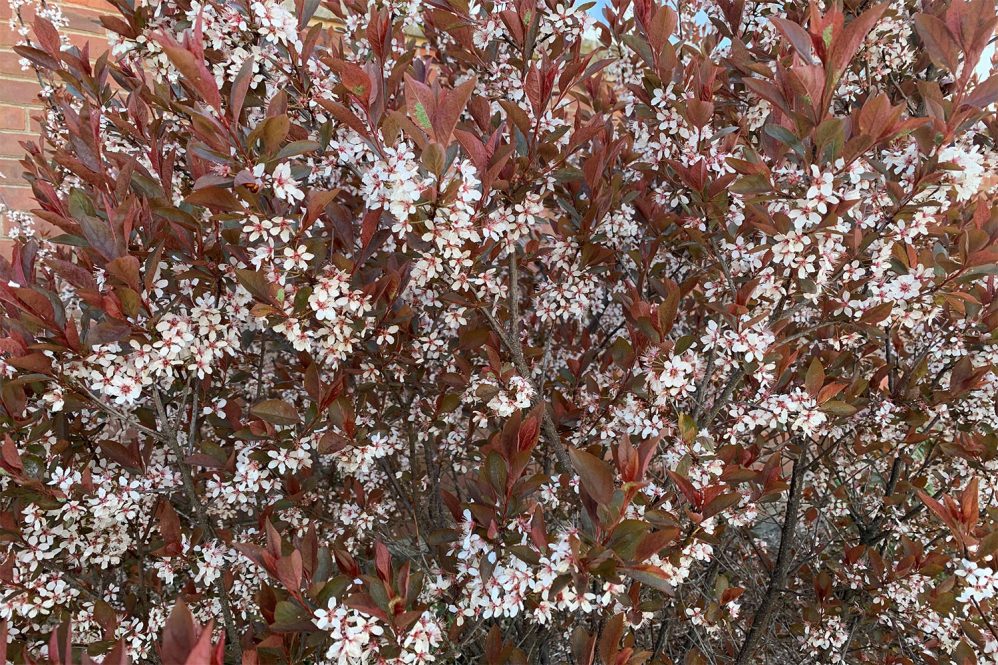This article originally appeared on CAHNR Newsroom.
Since 1988, Mark Brand, professor of horticulture in the Department of Plant Science and Landscape Architecture, has been involved in plant breeding yielding over thirty-eight plant introductions and twenty patented plants for the University. Each new cultivar takes at least ten to fifteen years to bring to market, while the patents help fund research at the College.
“I enjoy plant breeding because I envision certain crosses that will create a new plant,” Brand says. “From a scientific standpoint, it’s exciting to see science and genetics work the way I expected. Seeing how a new batch of seedlings turns out is like opening a present.”
The process involves years of research that requires multiple steps starting with learning everything there is to know about the targeted plant, making crosses, harvesting fruits and cleaning seeds, cold treatments to break seed dormancy and trigger germination, growing up seedlings and selecting superior individuals expressing desired traits.
One of the newest patented plants, Prunus pumila ‘UCONNPP002’, has been introduced at Bailey Nurseries based in St. Paul, Minnesota, and will hit the market this spring and be sold as Jade Parade sand cherry.
Sand cherry is a durable native shrub, and this cultivar is a cross between the ground cover form of the plant Prunus pumila var. depressa and Prunus pumila var. susquehanae, an upright shrub. Brand was looking for a plant with a growth pattern between a shrub and ground cover, and Jade Parade fit the bill, growing to about two feet tall and four feet wide. The plant is extremely durable, boasts dark olive-green foliage, and supports pollinators in the spring when the shrub is covered in white flowers. In the fall it turns a vibrant red-orange color. Jade Parade will also serve to replace Rhus aromatica ‘Gro Low’, an extremely popular mounded sumac that grows well in challenging locations. Unfortunately, ‘Gro Low’ has been severely impacted by a fusarium disease in the landscape causing widespread losses.
Another new patent was awarded for Prunus x cistena ‘UCONNPC001’, a compact form of purple leaf sand cherry. The purple leaf sand cherry that has enjoyed widespread use for about a century is too large for many landscapes topping out at about eight feet high and wide. Brand thought to create it again with the positive attributes of the purple leaf sand cherry, but in a smaller version. He remade the cross of Prunus cerasifera ‘Atropurpurea’ and Prunus pumila var. besseyi used to create the original Prunus x cisterna but switched out Prunus pumila var. besseyi with the prostrate-growing Prunus pumila var. depressa, to achieve a smaller end product. The new shrub is about four feet in height and width, but grows much fuller, particularly at the bottom where the original tended to become leggy. The new plant retains the purple leaves and profuse light pink flowers and is licensed to Monrovia Nursery Company under the trade name Dark Star.
Brand involves his students in the plant breeding process, many of whom stay in touch to find out the results of their early work. Bryan Connolly was one of Brand’s Ph.D. students to work on the Prunus plant. Connolly went on to a position at Framingham State University and is currently an assistant professor in the biology department at Eastern Connecticut State University.
Brand is collaborating with his wife, associate professor, Jessica Lubell, to promote and breed new cultivars of unusual native plants. The first is Comptonia peregrina ‘Blue Sea’, known as sweet fern, part of the bayberry family.
The sweet fern has a mild, pleasant scent and an interesting leaf shape. Brand and Lubell selected a seedling with a bit narrower leaf that exhibits a bluish tint and ended up with a plant that grew to a three-foot mound, with a denser form and habit than is typical for the species.
“We like to improve on the habit and ornamental attributes of native plants, so they more broadly appeal to people wishing to incorporate native plants into their landscapes,” Brand asserts. The sweet fern also fixes nitrogen through nodules on its roots that spread underground about six to eight feet.
The team chose another plant native to the Northeast to work on, Myrica gale, or sweetgale, which has a lot of landscape potential. The dioecious plant, also related to bayberry, is found all the way north to Canada and Alaska, but they chose parents from Connecticut so the plants they developed would be better adapted to the warmer conditions of Southern New England.
The dense, compact plant called Myrica gale ‘Lowboy’, grows about three feet high and wide, expressing a lime green color foliage and fragrant scent. The plant is male and will flower in early spring with yellow-orange catkin-type flowers.
This easy-to-grow plant fits in with a variety of landscape situations and performs nicely as a low border plant that does not require pruning or when massed together in full sun. It is adapted to moist or wet soils, but testing has shown it also will grow well in landscape situations with average soil moisture levels. It has been licensed to Prides Corner Farms and is in their American Beauties Native Plants line.
To create a niche for their patented native plants, Brand and Lubell also obtained a trademark of “Native Star.”
“We wanted a trademark to go along with our line of improved novel native plants that would alert the consumer that these are really good performing native plants,” Brand explains. “It’s nice to add these native plants into your landscape. They fit in well with the natural surroundings and support native pollinators, without any worry of them escaping and turning invasive.”



